Hiroshima Day Trip and Hiroshima Walking Tour
Hiroshima was tragically the site of the world’s first atomic bomb in 1945. When visiting Japan, it’s easy to take a day trip to Hiroshima from Osaka or Kyoto. Hiroshima is relatively small, which makes it the perfect place to explore on foot. I’ve designed a Hiroshima walking tour to cover the main Hiroshima attractions in just one day. However, if walking’s not your jam, you can also get between the sites by bus, subway or taxi.
Why Take a Hiroshima Day Trip?
Sometimes, I like to walk around wearing rose-tinted glasses that block out the horrors of our world. I wasn’t exactly sure how I’d feel about being confronted by Hiroshima’s nuclear history. While visiting Hiroshima was upsetting (to put it mildly), I am glad that I took a day trip to Hiroshima.
Yup, a visit to Hiroshima is emotional. It’s harrowing. It’s moving. Yet it can also be strangely uplifting, and can leave you with a cautious sense of hope. The atomic bomb has left an indelible scar on the city of Hiroshima, and the city acts as a living memorial to the horrific impact of atomic warfare. But this is also a city rebuilt. A city united. A city dedicated to eliminating nuclear war.
I can be a delicate petal, so was pleased to discover that there’s things to do in Hiroshima in addition to the Hiroshima Peace Memorial Park. My Hiroshima itinerary balances the raw devastation of the atomic bomb with other Hiroshima city sights.
How to Get to Hiroshima
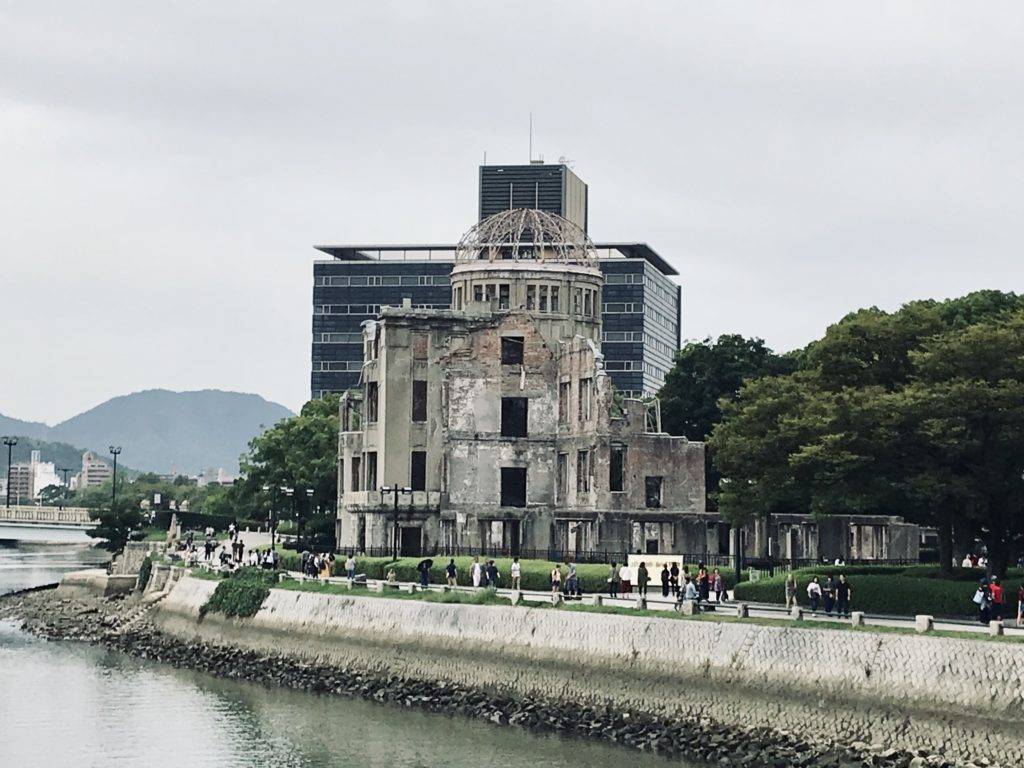
Hiroshima’s central location means that it works really well in a Japan itinerary. The best bases for a day trip to Hiroshima are Osaka and Kyoto, as the bullet train (Shinkansen) only takes around 1.5 hours each way. See the West Japan Rail site for timetable details.
There’s also a regular train from Osaka or Kyoto to Hiroshima, but this takes 6-7 hours and involves multiple transfers. Probably only recommended for long term and penny-pinching travelers!
Hiroshima from Osaka
You can get from Osaka to Hiroshima on the bullet train in around 1 hour 30 minutes. Take the Sanyo Shinkansen line from Shin-Osaka Station to Hiroshima Station.
If you have a Japan Rail Pass (which is the best value if you’re doing a couple of bullet train trips), use the Sakura service which takes around 1 hour 30 minutes or the Hikari service which takes around 2 hours 15 minutes. If you don’t have a JR Pass, you can also take the slightly faster Mizuho or Nozomi train to Hiroshima from Osaka at around 1 hour 25 minutes.
Hiroshima from Kyoto
If your Kyoto itinerary is a few days or more, then it’s absolutely worth taking a day trip to Hiroshima, and surprisingly doesn’t actually take much longer than travelling from Osaka to Hiroshima.
You can get from Kyoto to Hiroshima on the bullet train in around 1 hour 40 minutes. Take either the Sanyo Shinkansen or the Tokaido Shinkansen from Kyoto Station to Hiroshima Station.
If you have a JR Pass, you can use the Hikari or Sakura services which may require a transfer in Osaka, making a total one way trip time of around 2 hours. If you don’t have a JR Pass, you can also take the Nozomi service direct to Hiroshima from Kyoto.
Hiroshima from Tokyo
If you’re visiting Hiroshima from Tokyo, it is best to stay overnight in Hiroshima as the train from Tokyo to Hiroshima takes around 5 hours. Even better, add Osaka to your Japan itinerary, as you need to transfer via Osaka (or another station in the region) to reach Hiroshima from Tokyo.
Overview of Hiroshima Itinerary
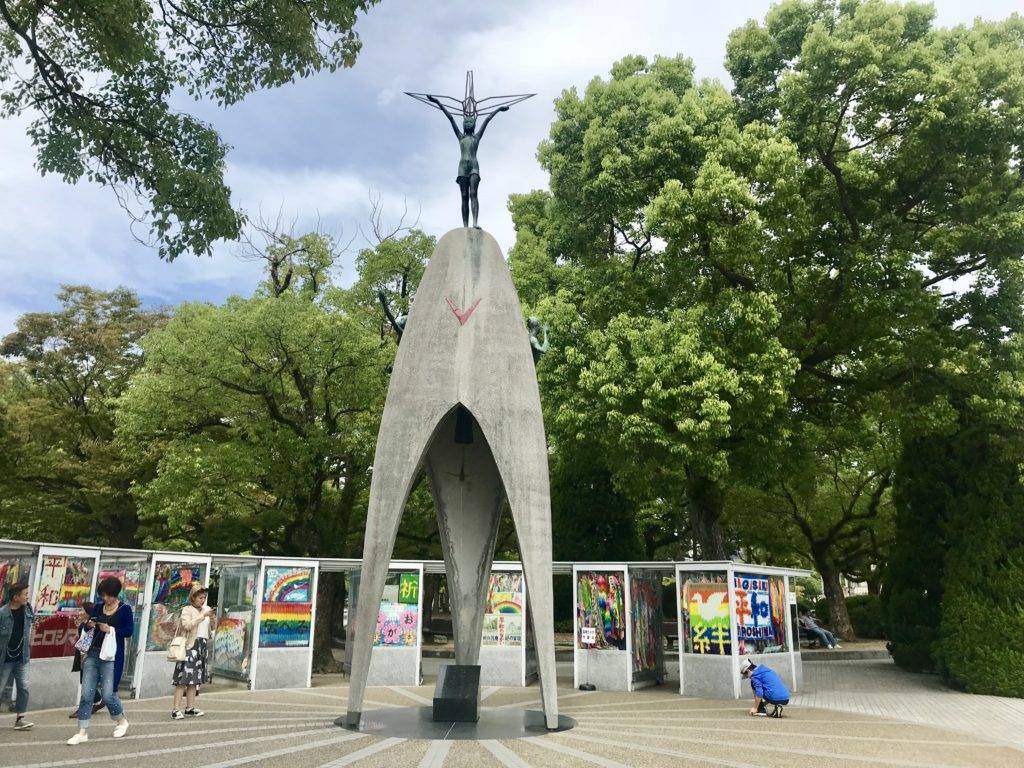
Children’s Peace Monument at Hiroshima Peace Memorial Park
Hiroshima Attractions Visited
For the first part of your Hiroshima day trip, you can almost forget (at least temporarily) that you’re walking across a city which was virtually flattened by the world’s first atomic bomb in 1945.
This Hiroshima 1 day itinerary eases you into things with a visit to Japanese gardens and a castle, followed by the (devastating) Hiroshima Peace Memorial Park, ending with time to decompress and look around the city.
Hiroshima Walking Distance
The Hiroshima walking tour below has around 10-12km walking. This includes 7 km between stops and another few km walking around the Hiroshima attractions. You can cut out a fair amount of the walking time with buses, the subway and taxis if you prefer.
Disclaimer: My walking tally was closer to 12km, but I spent a good 1.5km of that lost.
Lesson: Plan your Hiroshima walking route in advance with Google Maps!
Time Required for Hiroshima 1 Day Itinerary
All up, a day trip to Hiroshima will take around 10-12 hours.
This does make for a rather exhausting but fulfilling day. If you have more time to spend in Japan, you can also stay overnight in Hiroshima. If you have time, add in nearby Miyajima Island, which is famous for Itsukushima Shrine, a massive orange torri gate.
Transfers to Hiroshima
The bullet train to Hiroshima from Osaka or Kyoto takes roughly 1.5 hours each way / 3 hours return, or longer if you’re taking a slower Shinkansen.
If you are not staying near the Shinkansen station, you’ll need to factor in additional time to get to and from the station. I was staying in Shinsaibashi Osaka, and it took around 30 minutes to get from Shinsaibashi to Shin Osaka where the bullet trains departs from (15 minute train, plus walking / ticket buying time / getting lost in the station time).
Time in Hiroshima
Allow 6 – 8 hours door to door from Hiroshima Station for your Hiroshima one day itinerary, including walking, exploring and lunch time.
My Hiroshima self-guided walking tour took me 6 hours. My breakdown was roughly 2 hours for the garden, castle and shrine, 2 hours for the Memorial Peace Park, and 2 hours for lunch and the city. You may need longer than 6 hours if you walk slowly, love museums, like to take regular rests, or are traveling in a group (I was traveling to Hiroshima solo).
You can of course drop some Hiroshima activities if you prefer a shorter day, or take taxis, buses or the local subway between stops.
Hiroshima Walking Tour – Map and Directions

This Hiroshima walking route follows a round circuit of the city. The map and directions are available on Google Maps. Each stop is detailed below.
You don’t need to strictly follow the Hiroshima map route. In fact, I’d recommend having an aimless wander around the Hiroshima Memorial Peace Park (Stop 5) and Hiroshima City (Stop 6). Hiroshima is small, so if you wander off down an interesting street or get lost (as I did!), you can get back on course quickly by consulting Google Maps.
What to do in Hiroshima
The most popular things to do in Hiroshima are to visit the Hiroshima Peace Memorial Park and the Atomic Bomb Dome (Stops 4 and 5 below), which are the main memorial sites. You could easily spend an entire day in this area, particularly if you’re a history nut. However, I was keen to get a broader taste of the city, so added in additional stops when I was planning what to do in Hiroshima.
Stop 1: Shukkeien Gardens Hiroshima (Map B)
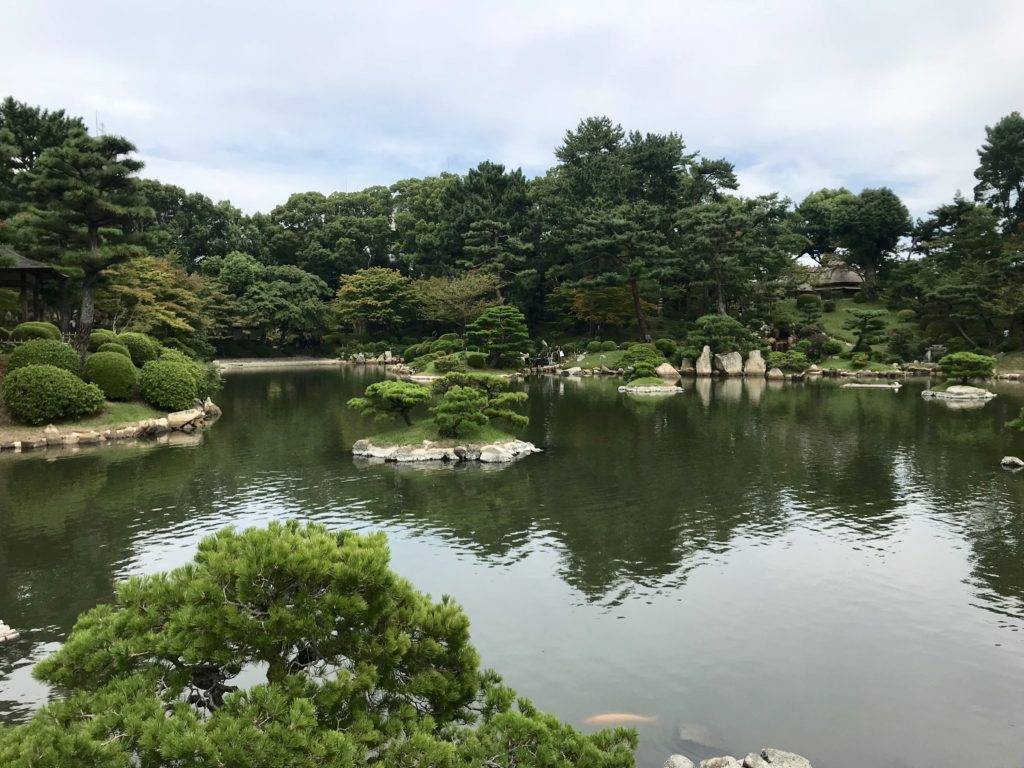
Overview of Shukkeien Gardens
Start your day in Hiroshima by taking an easy walk from Hiroshima Station to the tranquil Shukkeien Gardens (literally, ‘shrunken’ gardens). The original gardens date back to the 1600s, but were rebuilt after being destroyed by the 1945 atomic bomb.
There’s a path around the entire pond at Shukkeien Gardens, with many islets and bridges. The pond is full of (ridiculously large) colorful koi fish. Buy some koi food and create a feeding frenzy! Allow 30-45 minutes to walk around the gardens and feed the koi.
Walking Distance, Opening Hours and Cost
Distance: Shukkeien Gardens is around 1.1km walk from Hiroshima Station.
Opening Hours: Shukkeien Gardens is open daily from 9am until 5pm or 6pm, with closing time depending on the season.
Cost: The entry fee for Shukkeien Gardens is adults Y260 for the gardens and Y100 for koi (fish) food. If you’re into art, check out the Prefectural Art Museum at the gardens, adults Y510.
Stop 2: Hiroshima Castle (Map C)
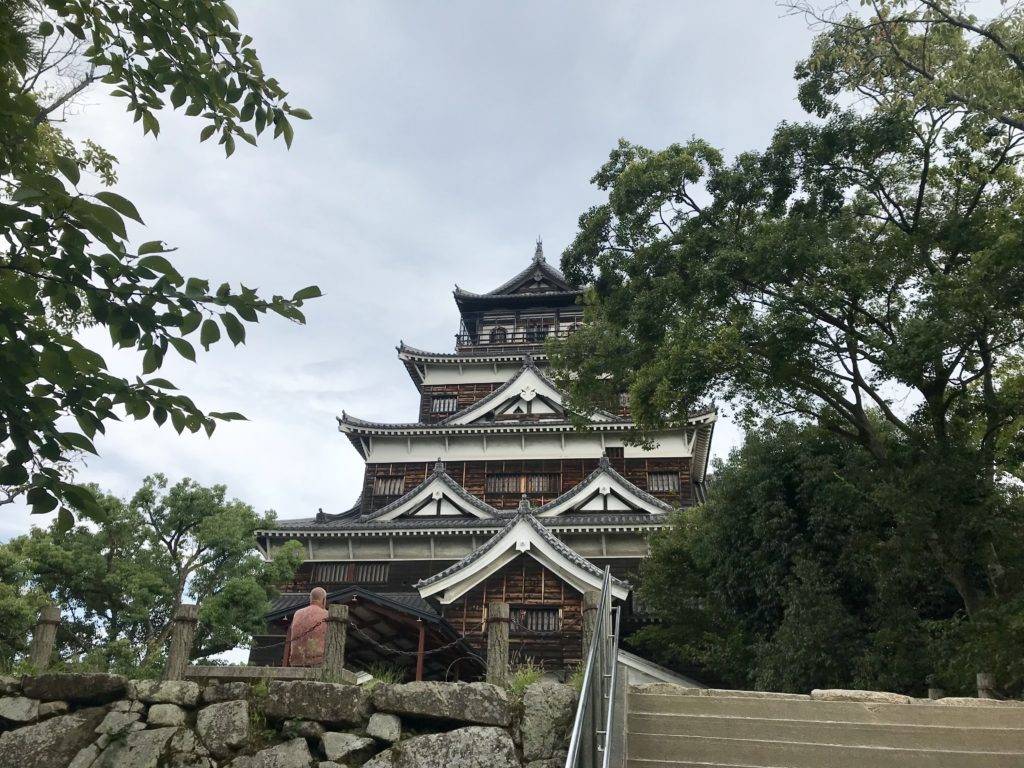
Overview of Hiroshima Castle
Next stop on your Hiroshima day trip is a classic Japanese castle. From Shukkeien Gardens, head slightly north west and you’ll reach Hiroshima Castle in around 10 minutes.
This historic castle was originally a 16th century castle for the feudal lords, and later served as a military facility. As with most local buildings, Hiroshima Castle was destroyed by the atomic bomb blast and was reconstructed in the 1950s.
Walk around the Hiroshima Castle grounds, view the picturesque wooden castle and pay to enter the castle if you want to learn about the castle’s history. The castle includes four floors of historic exhibits and a fifth floor observation deck. I took a quick squiz through the castle but, to be honest, I coulda given it a miss.
Walking Distance, Opening Hours and Cost
Distance: Hiroshima Castle is around 850 metres walk from Shukkeien Gardens.
Opening Hours: Hiroshima Castle is open daily from 9am to 5pm or 6pm, with closing time depending on the season.
Cost: Admission to Hiroshima Castle grounds is free. The fee to enter Hiroshima Castle is Y370 for adults.
Stop 3: Hiroshima Gokoku Shrine (Map D)
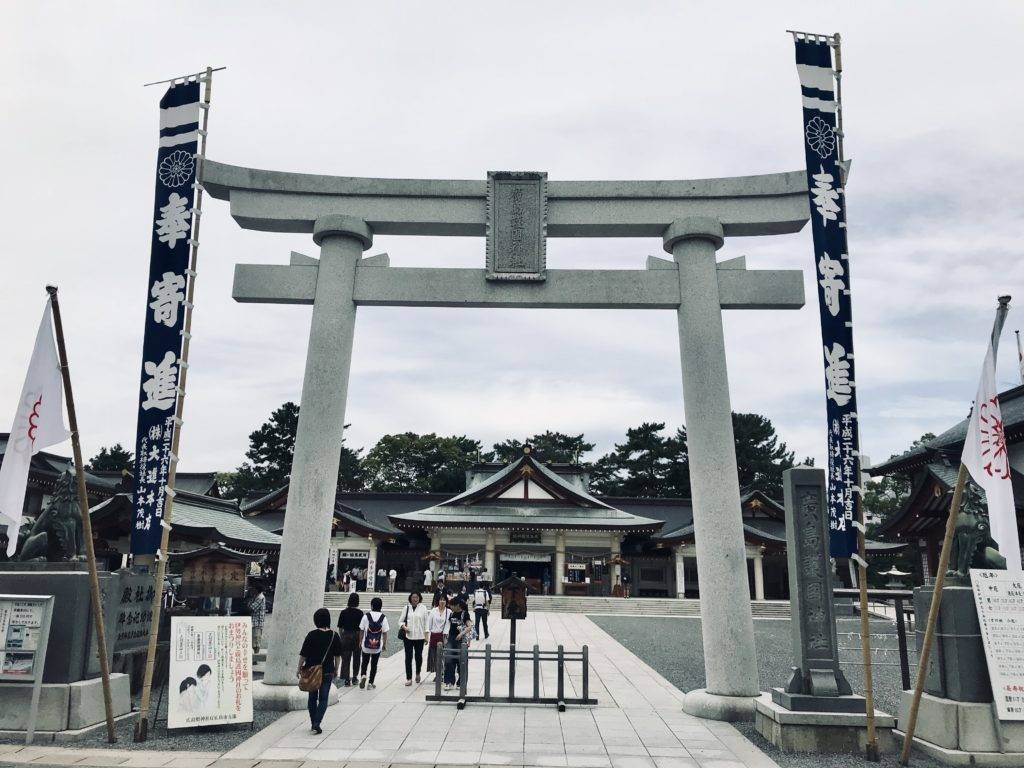
Overview of HiroshimaGokoku Shrine
The Hiroshima Gokoku Shrine is in the Hiroshima Castle grounds, on the way to the Atomic Bomb Dome. This Shinto shrine is a place of worship for war casualties, and includes traditional Shinto gates and a temple.
I walked past the Gokoku Shrine and admired the pretty gates, but didn’t go in. (I was getting my temple on the next day in Nara. See my Nara Walking Tour for deets!)
Walking Distance, Opening Hours and Cost
Distance: Gokoku Shrine is around 200m walk from Hiroshima Castle.
Hours: 9:00am to 4:30pm. You can walk past the shrine at any time.
Cost: Free to walk around the shrine grounds. There may be a small entry fee to go inside the shrine.
Stop 4: Hiroshima Atomic Bomb Dome (Map E)
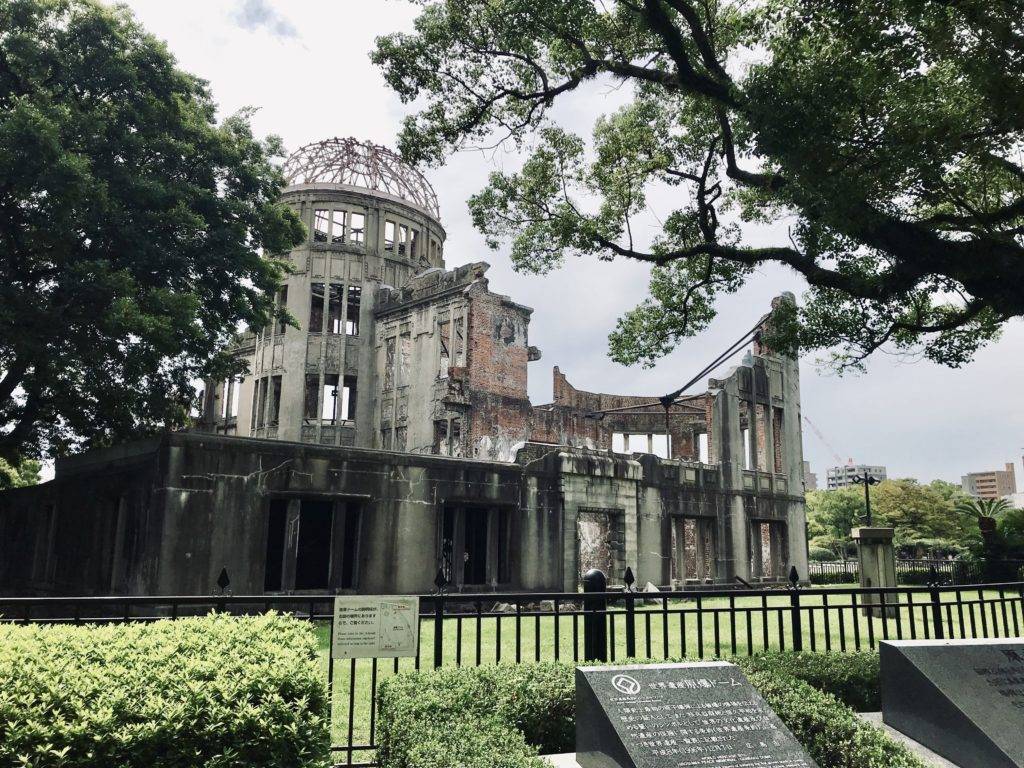
Overview of the Atomic Bomb Dome
This is where sh*t starts to get real my friends. Brace yourself, because Hiroshima’s horrific history suddenly gets a whole lot more visual. The A-Bomb Dome is located near the epicenter of the 1945 atomic bomb blast, which exploded 600 meters above this area.
The atomic bomb flattened much of Hiroshima and killed around 60,000 people instantly, 140,000 people by the end of 1945, and tens of thousands more in the following decades. The A-Bomb Dome is the only structure still standing from 1945, which makes it all the more eerie and atmospheric.
You can only walk around the outside of the A-Bomb Dome, so you won’t need a lot of time here.
Walking Distance, Opening Hours and Cost
Distance: The Atomic Bomb Dome is 1.3km walk from Hiroshima Gokoku Shrine.
Hours: The A-Bomb Dome is always ‘open’, as you can’t actually go inside the gates or the Dome.
Cost: Free.
Stop 5: Hiroshima Peace Memorial Park (Map F)
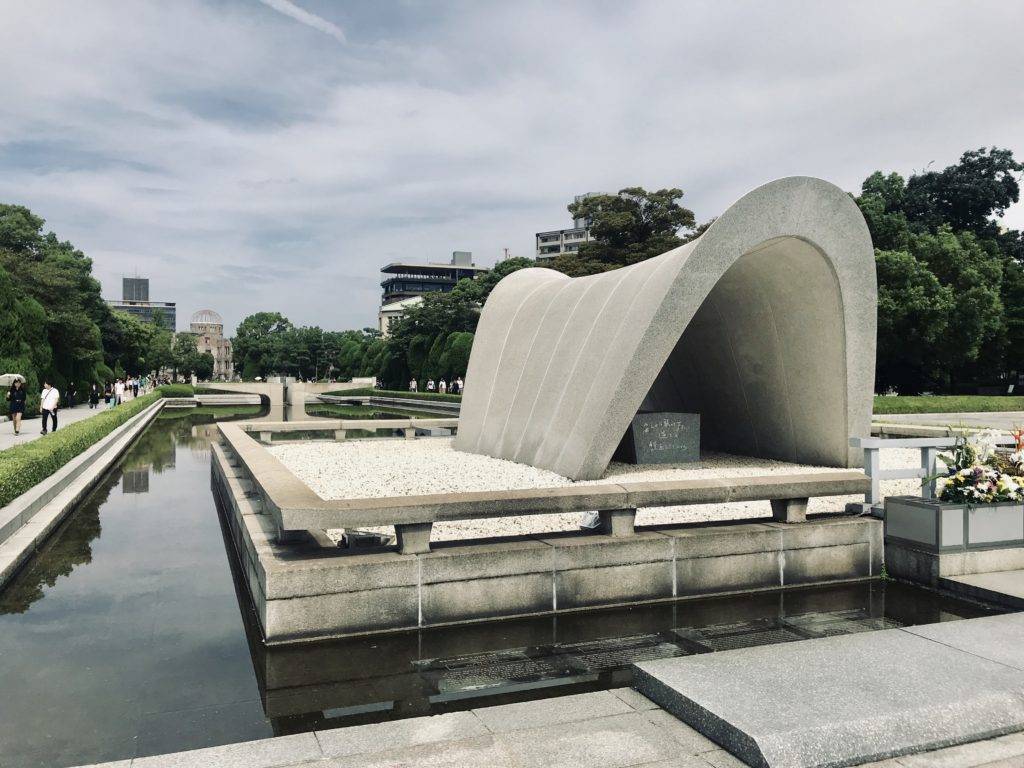
Overview of Hiroshima Peace Memorial Park
The next stop on your walking tour of Hiroshima is the Hiroshima Peace Memorial Park. This is the main Hiroshima memorial site, and includes several different memorials and a museum, set out below. Hiroshima Peace Park is the most popular Hiroshima attraction, and is usually the focus of a day trip to Hiroshima.
Hiroshima Outdoor Memorials
Start at the north end of Hiroshima Peace Memorial Park. Your first stop is the outdoor memorials. Walk past the Peace Bell (and give it a satisfying ring), the Children’s Peace Memorial, and the cenotaph where the eternal peace flame burns.
Hiroshima Memorial Hall of Remembrance
After the outdoor memorials, move onto two main indoor activities – the Memorial Hall and the Museum. Veer east from the cenotaph and you’ll find the Hiroshima Memorial Hall of Remembrance.
The Memorial Hall (above) is a moving 360 degree memorial depicting bombed cityscape. The city images are made up of 140,000 tiles, in memory of the number of atomic bomb victims at the end of 1945. (Bonus – entry is free!) This is one of the most visually interesting and moving memorials I’ve visited.
Hiroshima Peace Memorial Museum
After the Memorial Hall, walk south to the Hiroshima Peace Memorial Museum. The Museum depicts Hiroshima before, during and after the bombings. Watch the survivor video testimonies and check out artifacts like a watch that is permanently stopped at 8:15 am when the bomb hit.
The Hiroshima Museum also traverses the nuclear age post Hiroshima through the Cold War and to current times. This is a city scarred, but also a city on a relentless peace mission to eliminate atomic warfare.
The museum is not light viewing. The history and exhibits are intense and emotional, and many people (me included!) get a little teary and generally in a down mood at the state of our civilisation. Make sure you leave some time in your day to decompress and reflect.
Note: The Main Building at Hiroshima Peace Memorial Museum is closed for renovations and earthquake proofing until later in 2019. During this time, the East Museum is open and houses the main exhibits.
Walking Distance, Opening Hours and Cost
Distance: Hiroshima Peace Memorial Park is a few hundred meters walk from the Atomic Bomb Dome. You’ll probably add around 1km walking around the park, memorials and museum.
Hours: The Hiroshima Peace Memorial Museum is open 8:30am to 5pm or 6pm daily, depending on the season.
Cost: It is free to walk around Hiroshima Peace Park and the memorials, including the Hall of Remembrance. The entry fee to the Hiroshima Peace Memorial Museum is Y200 for adults.
Stop 6: Hiroshima City and (Late!) Okonomiyaki Lunch (Map G)
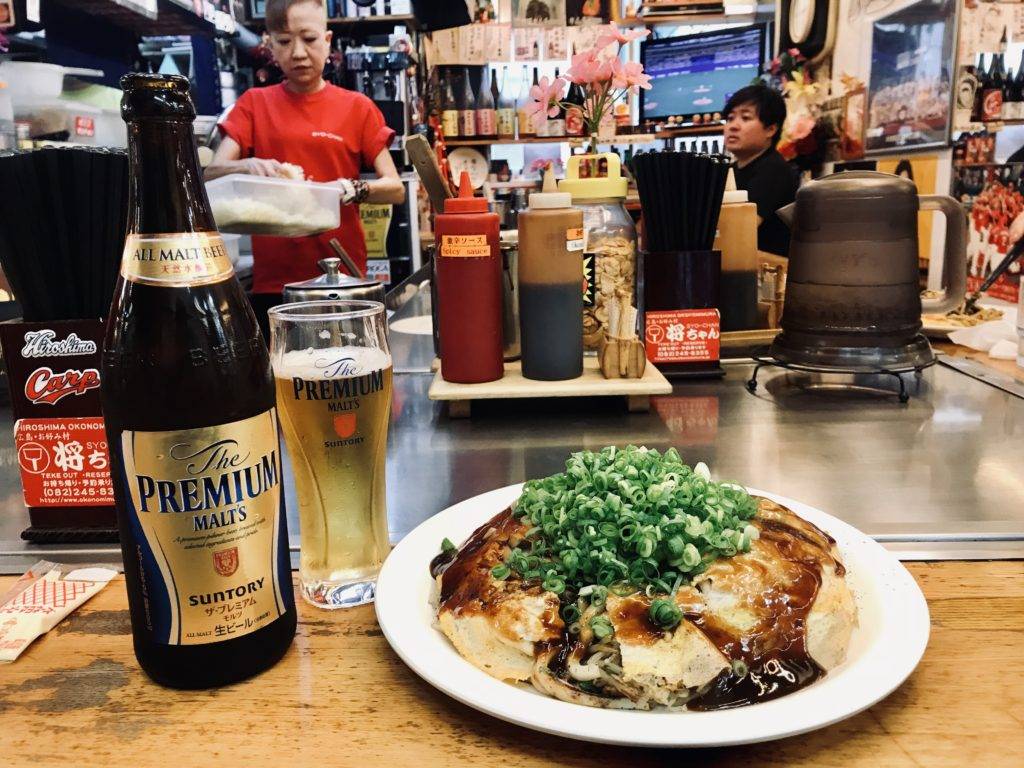
Overview of Hiroshima City
By now, you’ll be starving if you haven’t eaten already, and likely in need of some lighter activities after visiting the Hiroshima Memorial Park.
Spend the rest of the day walking through the city streets back to Hiroshima Station. If you’re into shopping, there’s shops galore to stock up on clothing or buy some crazy local Japanese souvenirs. I got distracted by gorgeous kitty-cats in a pet shop, and had some quality snuggle time. A day trip to Hiroshima also wouldn’t be complete without some tasty local treats.
Hiroshima Okonomiyaki
For lunch, try the famous Hiroshima style okonomiyaki, a pancake thingy*, washed down with some beer. (*Pancake thingy made of a flour base, layered with cabbage, sprouts, onions, tempura scraps, pork, noodles, egg and other optional extras. Yup, it’s massive!).
You’ll find okonomiyaki eateries dotted all over Hiroshima city. I had a couple in mind, but was thwarted by a long line at Okonomiyaki-Nagata-ya and shorter opening hours at Hassei.
I ended up at Okonomimura. Awesome accidental choice me, if I do say so myself. Okonomimura is on the third floor of a pretty nondescript building and has a few small Hiroshima okonomiyaki stalls. Plonk down at one of the stalls, order away, sit around a hot grill, and watch the magic happen.
I spent a good hour or so at Okonomimura resting my tired legs, having a beer, and watching the chefs at work. (And attempting to eat the world’s biggest Okonomiura – evidence above!)
Walking Distance
It’s around 1.2km to walk from Hiroshima Peace Memorial Museum to Okonomimura for lunch. You should factor in at least 2km walking total, as you’ll want to meander around the city.
Stop 7: Hiroshima Station (Map H)
Finish your Hiroshima day trip itinerary by walking back to Hiroshima Station (around 1.7km from Okonomimura) or your local accommodation. Local transport is also readily available.
If your legs have had it at any time during the day, jump in a taxi or on the local tram or subway to save a couple of kms walking. My legs were almost gone-burgers towards the end, but I trucked on, determined to finish my walking route of Hiroshima!
End of Hiroshima Day Trip: Back to Osaka or Kyoto!
If you have a spare day in Osaka, read my Osaka one day itinerary to hit the highlights in just one day!
If you’re travelling from Kyoto, check out my favorite things to do in Kyoto.
Note: This post contains affiliate links. This means that if you click on a link, I may make a small commission at no additional cost to you. Thanks for your support!
Like it? Pin it!
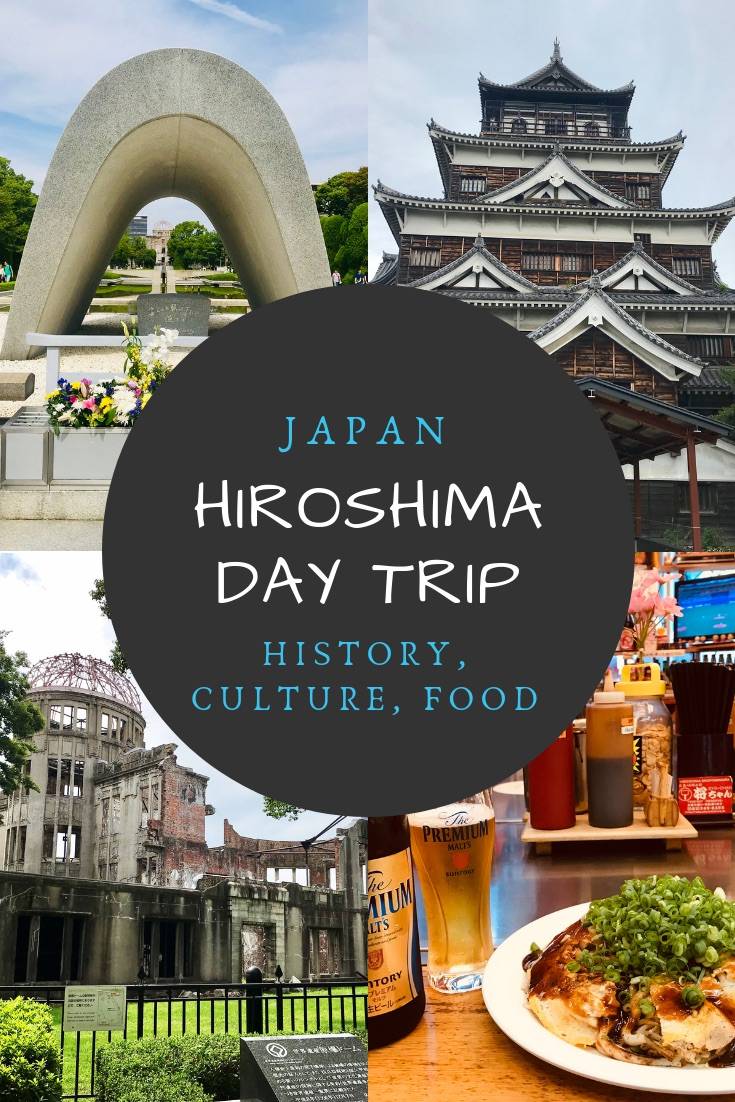
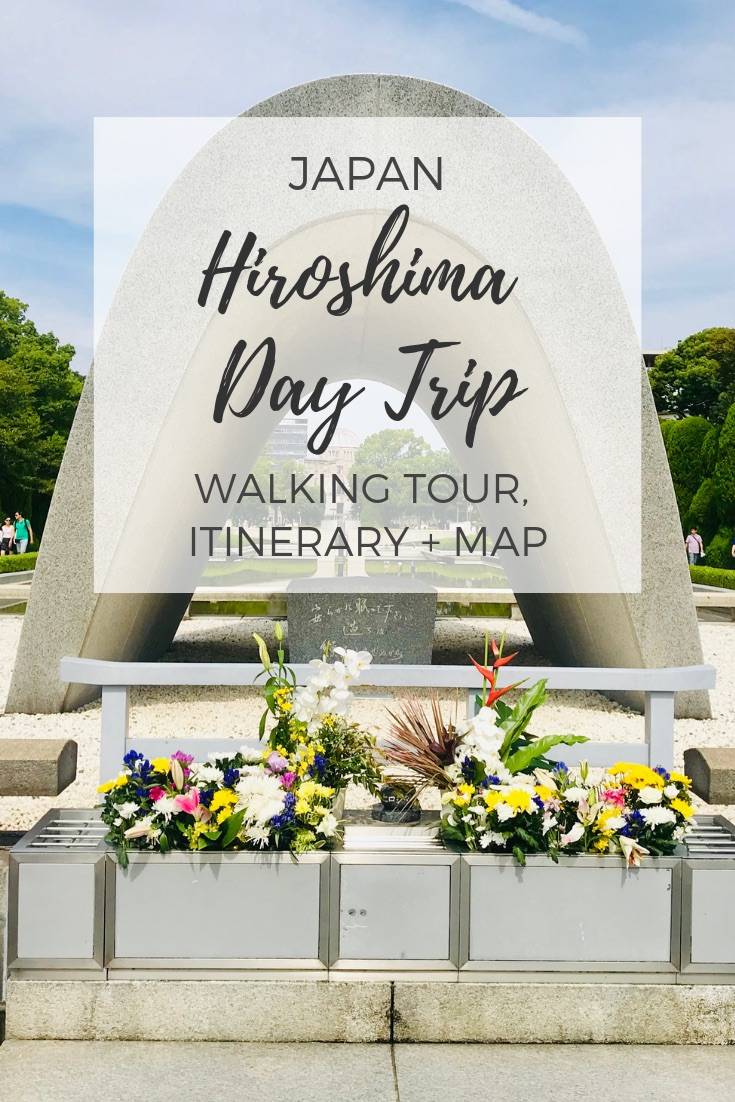
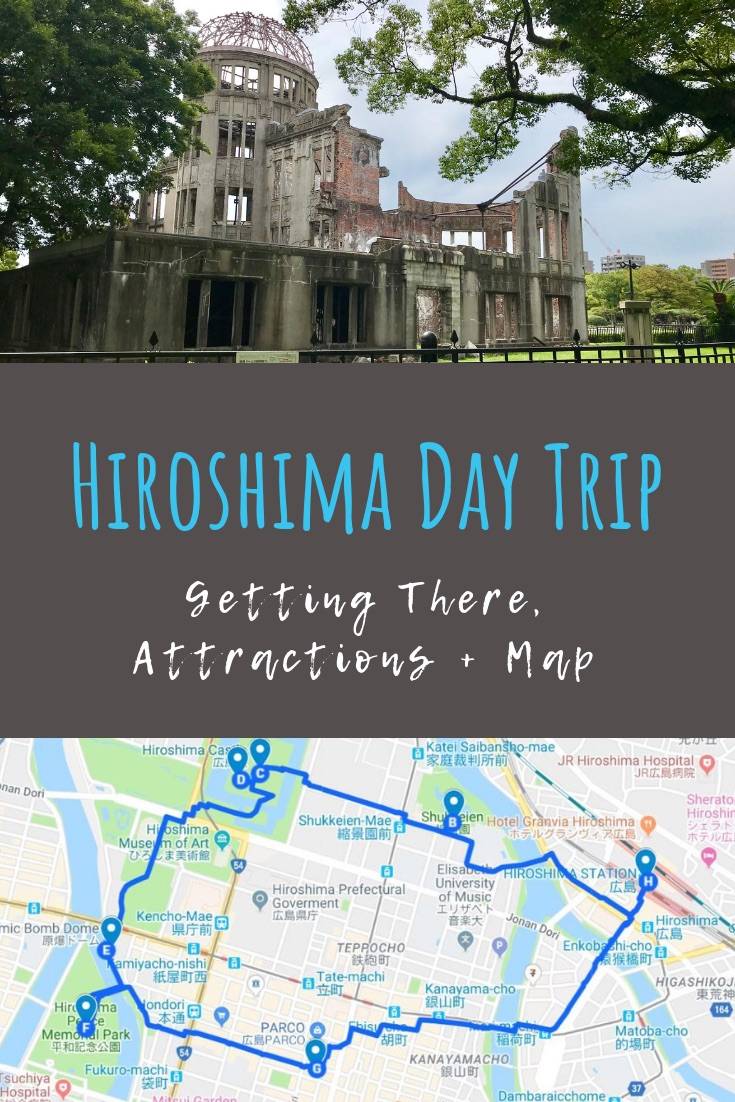

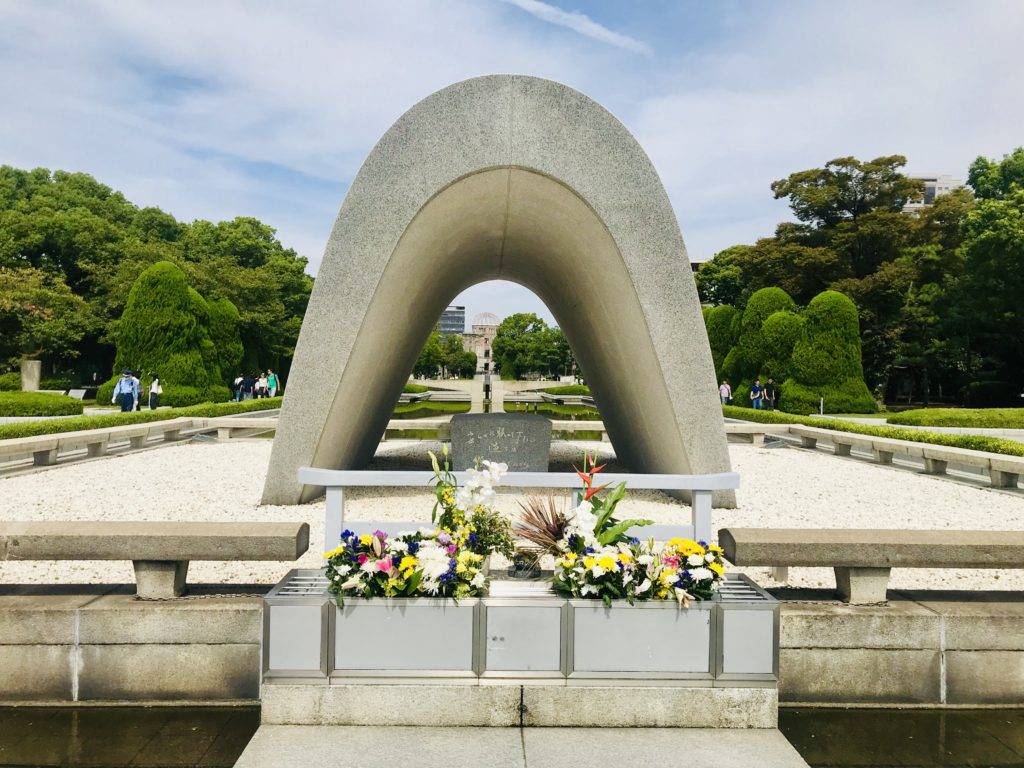
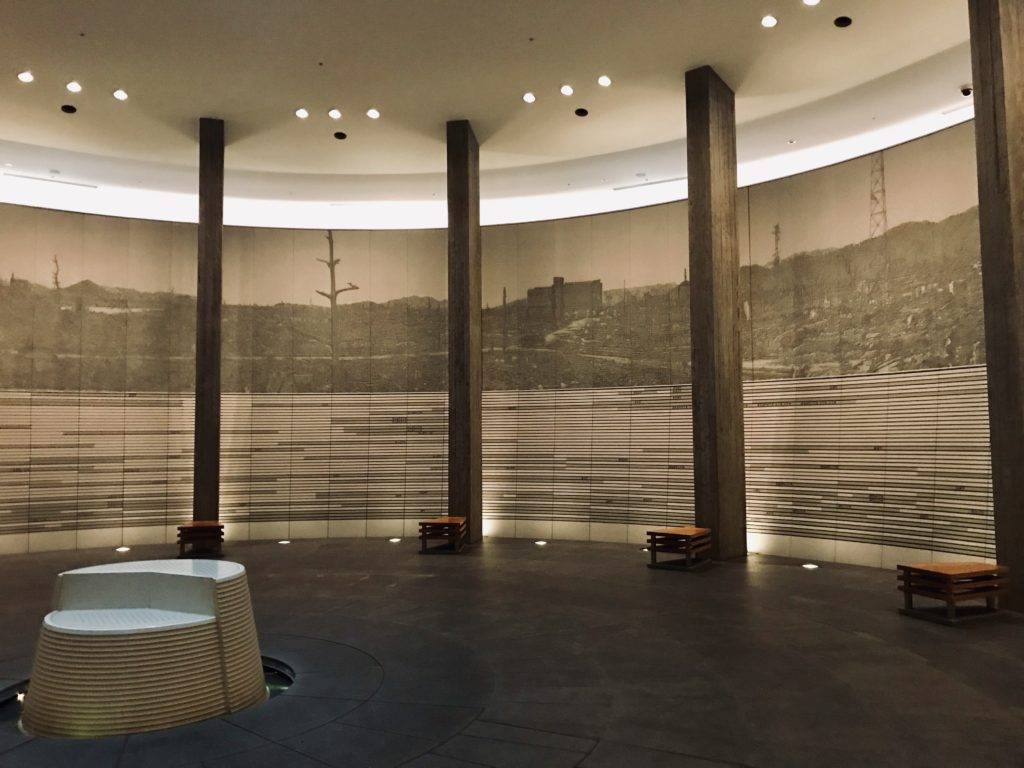

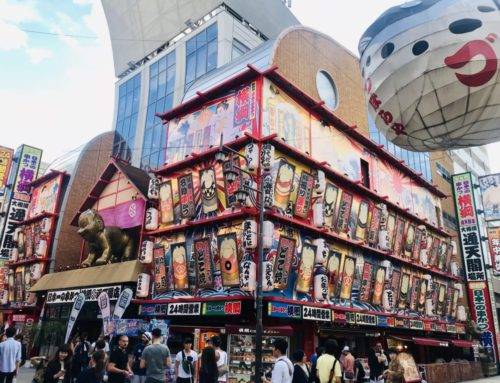
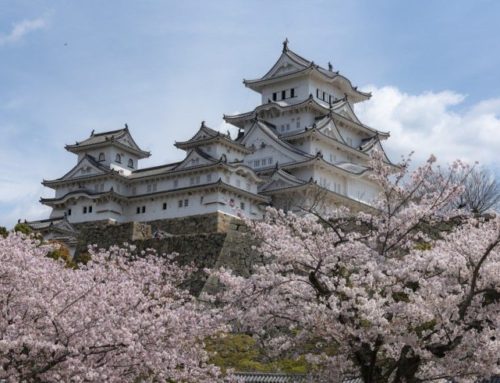

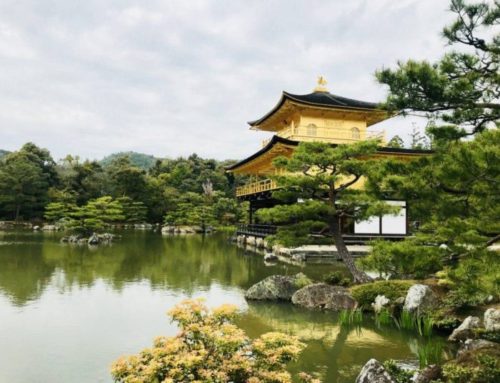
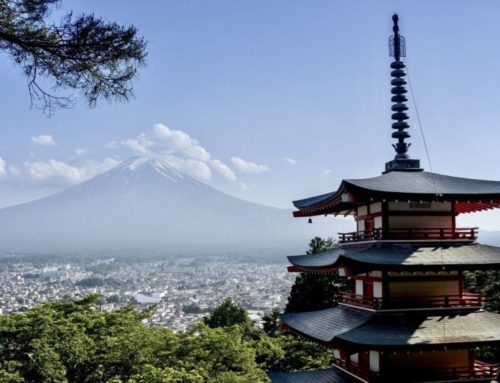
This is a great guide to Hiroshima! It was an interesting city to visit. It was haunting to see the A-Bomb done and the memorial museum.
Great guide & it’s on my list to visit when I finally return to Japan. I can totally relate to how you felt – I was the same when visiting the Killing Fields in Cambodia. So tough & emotional to hear about the history but also something that you need to do to even get close to understanding the horrors that wee endured. Thank you for sharing.
Its a great City with resilient and hopeful people for the end of Nuclear arms.